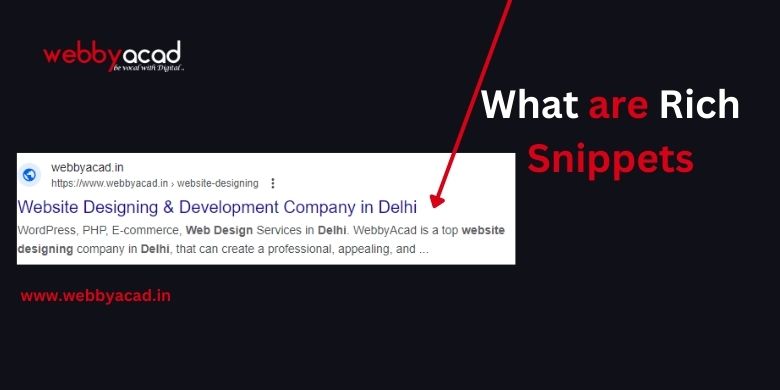Unlocking the power of rich snippets can have a profound impact on your website’s visibility and click-through rates. With search engine result pages becoming more competitive, rich snippets provide an excellent opportunity to stand out in the crowd. In this complete guide, we will explore the ins and outs of rich snippets. Helping you understand what they are, how they work, and how you can leverage them to drive more traffic to your website.
Whether you’re a business owner, marketer, or SEO professional, optimizing your content. To appear as a rich snippet can significantly improve your chances of attracting users’ attention and increasing organic traffic. We’ll dive into different types of rich snippets, including reviews, FAQ, recipes, and more, to give you a comprehensive understanding of the possibilities.
Additionally, we will walk you through the steps to implement structured data markup correctly. So search engines can easily understand and display your content as rich snippets. By the end of this guide, you’ll have the knowledge and tools to unlock the full potential of rich snippets and take your website to new heights. So, let’s get started and dominate the search engine results page!
Why are rich snippets important? What are they?
On the search engine results page (SERP), rich snippets are improved search results that offer more details about a website. They are designed to give users a preview of what they can expect from a webpage before they click on it. Rich snippets can include images, star ratings, reviews, pricing, availability, and more, depending on the type of content.
The importance of rich snippets stems from their ability to attract attention and improve click-through rates. By providing more context and visual elements in the search results. Rich snippets make your website stand out from the competition. They also help users make informed decisions about which result to click on, increasing the chances of driving qualified traffic to your site.
To leverage the power of rich snippets, you need to implement structured data markup on your website. This tells search engines what information to display as a rich snippet for your content. By providing structured data, you can enhance the visibility and relevance of your website in search results. Ultimately leading to more traffic and potential conversions.
Different types of rich snippets
There are various types of rich snippets that you can implement on your website, depending on the nature of your content and industry. Some of the most common types include:
- Reviews: This type of rich snippet displays star ratings and reviews for products, services, or businesses. It provides valuable social proof and helps users make informed decisions.
- FAQ: Frequently Asked Questions (FAQ) rich snippets display a list of commonly asked questions and their corresponding answers. This format is useful for providing quick answers to users’ queries and establishing your expertise.
- Recipes: Recipe rich snippets display cooking instructions, ingredients, ratings, and other relevant information. They are particularly useful for food bloggers, recipe websites, and cooking enthusiasts.
- Events: Event rich snippets provide details about upcoming events, including dates, times, locations, and ticket availability. If you organize or promote events, this type of rich snippet can help drive attendance.
- Products: Product rich snippets display information such as price, availability, and reviews for specific products. They are especially beneficial for e-commerce websites looking to showcase their offerings in search results.
These are just a few examples of the many types of rich snippets available. The key is to identify the type that aligns with your content and industry, as this will have the greatest impact on attracting relevant users to your website.
Using rich snippets on your website: How to do it
Structured data markup must be inserted into your HTML code in order to implement rich snippets on your website. Search engines can create rich snippets for your material using this markup since it gives them the information they need. Here is a step-by-step instruction sheet to get you going:
- Identify the appropriate schema: Schema.org is a collaborative project between major search engines that provides a standardized vocabulary for structured data markup. Visit the Schema.org website and identify the schema that corresponds to the type of rich snippet you want to implement.
- Add the structured data markup: Once you’ve identified the schema, you need to add the appropriate structured data markup to your HTML code. This can be done manually or by using a plugin or tool that generates the markup for you. Make sure to follow the guidelines provided by Schema.org to ensure your markup is valid.
- Test the markup: Before deploying the structured data markup on your live website, it’s crucial to test it using Google’s Structured Data Testing Tool. This tool allows you to see how search engines interpret your markup and identify any errors or warnings that need to be addressed.
- Monitor and maintain: After implementing rich snippets, it’s important to regularly monitor their performance and make any necessary adjustments. Keep an eye on your search analytics data to see how rich snippets are impacting your click-through rates and organic traffic. Additionally, stay updated with any changes to the schema or guidelines to ensure your markup remains valid and effective.
By following these steps, you can ensure that search engines understand and display your content as rich snippets, maximizing your chances of attracting users’ attention and driving more traffic to your website.
Best practices for optimizing rich snippets
Optimizing your content for rich snippets goes beyond implementing structured data markup. Here are some best practices to improve the visibility and effectiveness of your rich snippets:
- Focus on relevant content: Ensure that the content you’re optimizing for rich snippets is highly relevant to the search query. The more closely your content aligns with the user’s intent, the higher the chances of your rich snippet appearing in the search results.
- Use descriptive titles and meta descriptions: Craft compelling titles and meta descriptions that accurately summarize the content of your page. This helps search engines understand the context of your content and display relevant information in the rich snippet.
- Include high-quality images: Visual elements can significantly enhance the appeal of your rich snippet. Use high-quality images that are relevant to your content to captivate users.’ Attention and entice them to click through to your website.
- Leverage user-generated content: Reviews, ratings, and testimonials can add credibility and social proof to your rich snippets. Encourage users to leave feedback and showcase positive reviews to increase the chances of attracting clicks.
- Optimize for mobile: With the majority of searches now happening on mobile devices, it’s crucial to ensure that your rich snippets are optimized for mobile display. Make sure your website is mobile-friendly and that the structured data markup is correctly implemented for mobile users.
By following these best practices, you can enhance the visibility and appeal of your rich snippets. Increasing the chances of attracting users’ attention and driving more organic traffic to your website.
Tools to help with rich snippet optimization
Implementing and optimizing rich snippets can seem daunting, but luckily, there are several tools available to simplify the process. Here are some tools that can help you with rich snippet optimization:
- Google’s Structured Data Testing Tool: This tool allows you to test your structured data markup and identify any errors or warnings. It provides real-time feedback on how search engines interpret your markup, helping you ensure its accuracy and effectiveness.
- Schema Markup Generator: If you’re not familiar with HTML or prefer a more user-friendly approach, a schema markup generator can create the necessary structured data markup for you. Simply input the relevant information, and the generator will produce the markup code that you can copy and paste into your HTML.
- Yoast SEO: If you’re using WordPress, Yoast SEO is a popular plugin that not only helps with general SEO optimization but also includes features for implementing structured data markup. It provides an easy-to-use interface for adding rich snippets to your content without the need for coding.
- Google Search Console: Google Search Console is a free tool provided by Google that allows you to monitor your website’s performance in search results. It provides insights into how your rich snippets are performing and allows you to identify any issues that may need attention.
These tools can streamline the process of implementing and optimizing rich snippets, making it easier for you to unlock their full potential and drive more traffic to your website.
Common mistakes to avoid when using rich snippets
While rich snippets can be highly beneficial, there are some common mistakes that you should avoid to ensure their effectiveness. Here are a few key pitfalls to watch out for:
- Irrelevant or misleading markup: Implementing structured data markup that doesn’t accurately represent the content of your page can lead to penalties from search engines. Make sure your markup aligns with the actual content to maintain credibility and avoid potential penalties.
- Over-optimization: While it’s essential to optimize your content for rich snippets, be cautious not to overdo it. Keyword stuffing, excessive use of structured data markup, or other aggressive optimization tactics can harm your website’s visibility and reputation.
- Ignoring schema guidelines: Schema.org provides detailed guidelines for each schema type. Failing to follow these guidelines can result in your markup being ignored or not displayed correctly in search results. Take the time to familiarize yourself with the guidelines and ensure your markup adheres to them.
- Neglecting mobile optimization: With the increasing prevalence of mobile searches, it’s crucial to ensure your rich snippets are optimized for mobile display. Failure to optimise for mobile can lead to a bad user experience and decreased click-through rates.
By avoiding these common mistakes, you can ensure that your rich snippets are effective, relevant, and compliant with search engine guidelines, maximizing their impact on your website’s visibility and organic traffic.
Conclusion
Rich snippets offer a powerful opportunity to enhance your website’s visibility, attract users’ attention, and drive more organic traffic. By implementing structured data markup correctly and optimizing your content for rich snippets. You can unlock their full potential and stand out in the competitive search engine results page.
Look at these my blog post headlines. They are incredibly precise and to the point. Clicking on the posts will give you what you expect.




